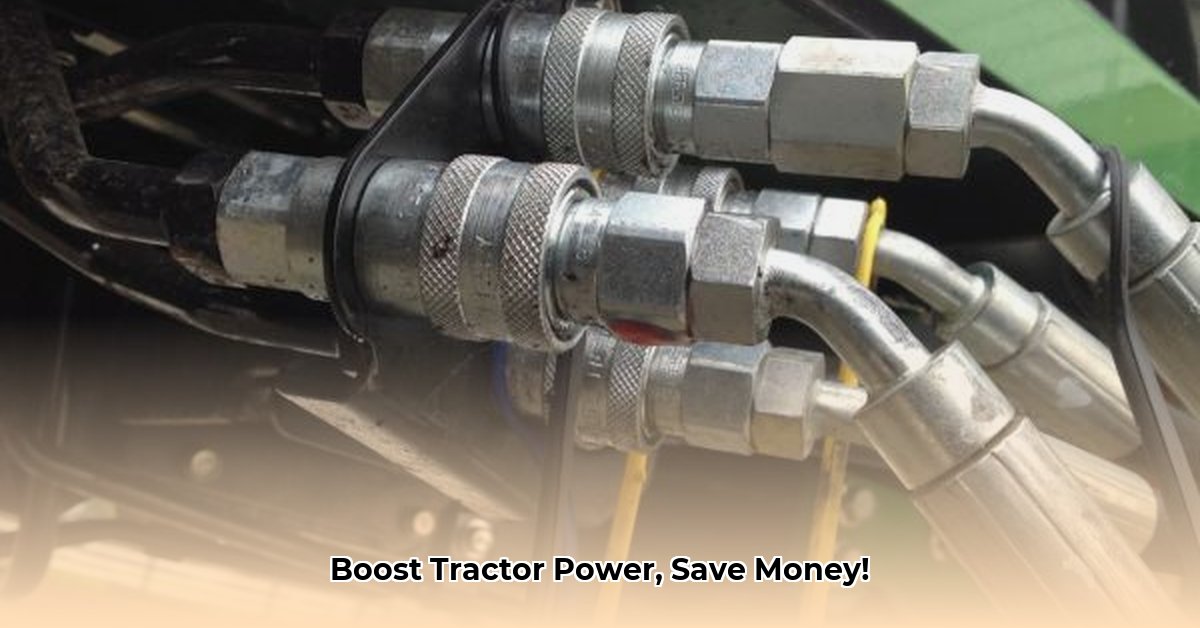
Hydraulic Tractor Fittings: The Unsung Heroes of Sustainable Farming
Your tractor's hydraulic system is its lifeblood, and its fittings are the crucial connections ensuring smooth operation. Neglecting these seemingly small components can lead to costly downtime, wasted resources, and environmental damage—all impacting your farm's bottom line and sustainability efforts. This guide provides practical, actionable steps to optimize hydraulic fitting performance, improving efficiency and minimizing environmental impact. For more in-depth information, check out this helpful resource.
Understanding Your Tractor's Hydraulic Fittings: A Deep Dive
Hydraulic fittings are not all created equal. They vary in size, shape, pressure rating, and material—each designed for specific applications and pressure levels. Mismatched or low-quality fittings lead directly to leaks, breakdowns, and expensive repairs. Understanding these differences is critical for selecting and maintaining the correct components for your tractor's hydraulic system. Do you know the pressure rating of each fitting on your tractor? Are they the correct type for your system's demands?
Regular Inspections: Your First Line of Defense Against Hydraulic Failures
Proactive maintenance is paramount. Regular inspections are like a health check for your tractor’s hydraulic system. What should you look for?
- Leaks: Even minor leaks waste hydraulic fluid and indicate potential larger problems. Address these immediately.
- Corrosion: Rust weakens fittings, creating failure points. Look for discoloration or pitting, indicating corrosion.
- Damage: Inspect for physical damage such as bends, cracks, or impact marks. Damaged fittings are unreliable and must be replaced.
- Tightness: Loose connections inevitably lead to leaks. Ensure all fittings are securely fastened.
A quick visual inspection every few weeks—more frequently during peak seasons—can prevent costly breakdowns and extend the lifespan of your components. What percentage of your downtime is attributed to hydraulic fitting failures? Reducing this number through preventative maintenance directly translates to increased profit.
Selecting the Right Hydraulic Fittings: A Guide to Sustainable Choices
Choosing the correct fittings is crucial for both efficiency and sustainability. Don't compromise on quality; consider these factors:
- Pressure Rating: Always choose fittings with a pressure rating exceeding your system's maximum operational pressure. Underestimating this can lead to catastrophic failure.
- Material: Durable, corrosion-resistant materials such as stainless steel extend lifespan and reduce replacement frequency. Consider the environmental impact of the chosen material's production and end-of-life management.
- Compatibility: Ensure the chosen fittings are compatible with your tractor's hydraulic system. Using incompatible fittings results in inefficient operation and potential damage.
Dr. Emily Carter, Agricultural Engineering, Purdue University: "Choosing sustainable fittings means considering the entire lifecycle, from material sourcing to disposal. Prioritize durable, recyclable materials whenever possible."*
Maintenance Strategies: Extending the Life of Your Hydraulic Fittings
Proactive maintenance is a cost-effective strategy that minimizes downtime and maximizes lifespan.
- Regular Fluid Changes: Clean hydraulic fluid ensures proper lubrication, reducing wear and corrosion on fittings and other components. Adhere to the manufacturer's recommended fluid change intervals.
- Proper Storage: Protect spare fittings from the elements to prevent corrosion. Store them in a clean, dry location.
- Careful Handling: Avoid banging or dropping fittings during installation or maintenance. Gentle handling extends their operational life.
The High Cost of Neglect: Financial and Environmental Impact
Ignoring hydraulic fitting maintenance has profound consequences. Downtime during critical operations like planting or harvesting translates to lost revenue and potential crop failure. Furthermore, leaking hydraulic fluid contaminates soil and water, harming the environment. Effective maintenance improves not only your farm's profitability but also its environmental stewardship. How much hydraulic fluid is lost annually on your farm due to fitting failures?
Stakeholder Impact and Long-Term Vision: A Holistic Approach
Sustainable farming necessitates a holistic approach that considers the impact on all stakeholders involved.
| Stakeholder | Short-Term Impact | Long-Term Impact |
|---|---|---|
| Farmer/Farm Manager | Reduced downtime; fewer repairs; improved operational efficiency | Increased profitability; reduced environmental footprint; enhanced farm sustainability |
| Manufacturer | Increased demand for durable, sustainable fittings; development of new materials | Innovation in design and materials; improved manufacturing processes for lower environmental impact |
| Government/Regulator | Fewer environmental incidents; promotion of sustainable farming practices | Clearer guidelines and standards for sustainable hydraulic fittings; incentives for eco-friendly choices |
By prioritizing high-quality, durable, and sustainable hydraulic fittings, you reduce long-term costs, minimize environmental damage and contribute to a healthier, more profitable farming operation. "Investing in proper maintenance is an investment in your farm’s long-term future," states John Miller, Farm Management Consultant, Iowa State University.
How to Choose Sustainable Hydraulic Fittings: A Practical Guide
Key Takeaways:
- Selecting appropriate hydraulic fittings is integral to maximizing farm efficiency and adopting a sustainable agricultural approach.
- Consider the entire lifecycle of fittings—from production to disposal—when making procurement decisions.
- Consistent maintenance significantly extends hydraulic fitting lifespan, reducing waste.
- Various sustainable options—materials and practices—offer both economic and environmental benefits.
- Collaboration with suppliers can ensure access to environmentally-friendly components.